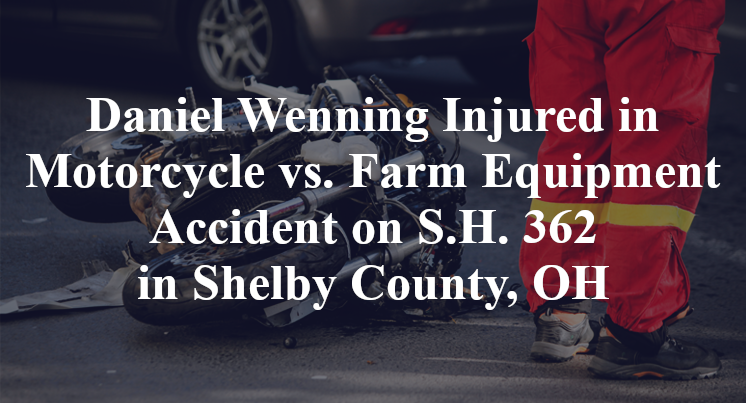Daniel Wenning Injured in Motorcycle vs. Farm Equipment Accident on S.H. 362 in Shelby County, OH
Shelby County, OH — June 2, 2025, Daniel Wenning was injured in a motorcycle versus farm sprayer accident shortly after 3:30 p.m. along State Highway 362.
According to authorities, 74-year-old Daniel Wenning was traveling on a motorcycle on S.H. 362 in the vicinity of Lake Loramie State Park when the accident took place.

The motorcycle was apparently attempting to pass the farm sprayer just as the sprayer was making a turn; a collision consequently followed between the motorcycle and the equipment. Wenning reportedly sustained serious injuries as a result of the wreck; he was flown to an area medical facility in order to receive immediate treatment. Additional details pertaining to this incident are not available at this point in time. The investigation is currently ongoing.
Commentary by Attorney Michael Grossman
When a motorcycle collides with a piece of agricultural equipment on a public highway, there are bound to be questions—not just about who had the right of way, but about whether either vehicle’s actions created a danger that could have been avoided. The key legal issue here is whether the farm sprayer operator signaled or checked for traffic before turning—and whether the motorcyclist had any reasonable opportunity to avoid the collision.
Farm machinery like sprayers are legal on many rural roads, but they come with special risks. They're often oversized, slow-moving, and difficult to see around—especially on narrow two-lane highways. That means they have a duty to operate with extra caution, especially when turning across oncoming or passing lanes. If a sprayer operator initiates a turn without fully checking for trailing or overtaking vehicles, the consequences can be catastrophic—particularly for smaller, more vulnerable vehicles like motorcycles.
That’s why the investigation must focus on what both operators were doing in the seconds before the crash. Did the sprayer have its turn signals activated? Did the operator look behind before turning, or rely solely on mirrors—which may have blind spots? Did the motorcycle have a clear path, or was it attempting to pass in a marked no-passing zone? These aren’t just technicalities—they’re the core of how fault is determined.
In my experience, cases like this often come down to situational awareness and timing. I’ve handled wrecks where a turning farm vehicle created a hazard by failing to account for faster-moving traffic behind it. I’ve also seen instances where a passing vehicle misjudged the slower one’s intentions because signals were missing or unclear. Neither scenario is simple, and both can carry legal consequences.
It’s also worth considering whether the sprayer was properly equipped for road use. Was it outfitted with reflectors, warning signage, and functional turn indicators? Agricultural machinery is allowed on public roads, but only if it meets certain visibility and safety requirements. If any of that was missing, it could tip the scales of responsibility.
Key Takeaways:
- Legal responsibility may hinge on whether the farm sprayer signaled and checked for traffic before turning.
- Investigators should assess sightlines, road markings, and whether either vehicle had a reasonable chance to avoid the collision.
- Agricultural vehicles must meet visibility and signaling standards when operating on public roads.
- Timing, awareness, and equipment condition are central to determining fault in this type of rural highway crash.
- A thorough investigation will be needed to understand the full sequence of events and whether the crash was preventable.

“These are essential reads for anyone dealing with the aftermath of a truck wreck”– Attorney Cory Carlson